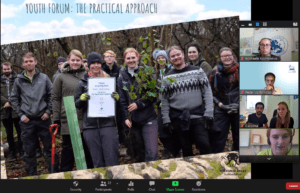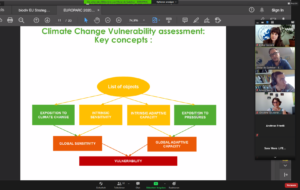This year, the Conference hosted 8 interactive workshops – 4 parallel each day – focused on Practice and Capacity Building in different sub-fields of Protected Area management. In the two-hour online sessions, speakers shared inspiring case studies relating to the topic of each thematic workshop, followed by open discussion with participants in the second part.
Download the Workshop presentations:
Day 1
Workshop 1: How can Protected Areas complete the Natura 2000 network?
A coherent network of Protected Areas is central to the implementation of Natura 2000. Benefitting from the LIFE e-Natura2000.edu project, this workshop will discuss what personal and organisational skills, knowledge and competencies are required to improve practical management effectiveness and what professional development systems require to be put in place to achieve the ambitions of the EU Biodiversity Strategy.
Case Study: Understanding and communicating with people to instil change and enhance collaboration, by Marie Micol (National Association For Areas Of Outstanding Natural Beauty, UK)
Presentation: eNatura2000 Mobile App, by Anne Magnus & Rupam Amrit (Symantra)
Workshop 2: Agriculture in parks: how can we communicate to farmers, with farmers, for farmers?
In the EU Biodiversity Strategy 2030, in the EU Farm to Fork Strategy and in the future Common Agriculture Policy, farmers are identified as key actors to produce healthy food, preserve biodiversity and nature resources, and provide ecosystem services. A good dialogue and a good reciprocal knowledge among farmers, administrators and consumers is necessary to reach these goals.
Case study: How Walloon Nature Parks promote a better communication with farmers?, by Baptiste Hottekiet (Director of NP Pays des Collines, BE)
Presentation: The EU new strategies: Biodiversity 2030 and Farm To Fork, by Stefania Petrosillo (EUROPARC Policy Officer)
Workshop 3: Nature on the front line: how do we ensure healthy parks, healthy people in periurban Europe?
COVID-19 has demonstrated the importance of nature close to home. At the same time though, the proximity of our periurban parks to some of the most densely populated areas in the world brings a unique set of management challenges which need to be addressed. There is a range of good practice to draw on in many European countries which shows how this can be done effectively. This workshop explored these issues and provide practical solutions through the work of the EUROPARC Federation commissions on health and periurban parks.
Introduction: Healthy Parks, Healthy People Europe – Issues and opportunities for periurban parks and Protected Areas, by Pete Rawcliffe (Head of NatureScot’s People and Places Activity; Europarc Federation Council Member)
Case Study: A health perspective: delivering triple-wins for health equity and nature in peri-urban Europe – key lessons from INHERIT, by Ingrid Stegeman (EuroHealthNet)
Workshop 4: Outdoor sports – how do we measure the benefits they bring to people and Protected Areas?
Protecting our landscapes and natural areas is an issue of significant importance to outdoor sports enthusiasts as well as those involved in conservation. Through the Benefits of Outdoor Sports to Society (BOSS) project that ENOS undertook over the past few years we have explored the range of benefits that outdoor sports provide and how to value these effectively in economic terms. One such benefit was how outdoor sports can connect people and especially young people to nature, make them appreciative of their natural surroundings and engender a desire to protect and look after it. The workshop looked at how to we can determine the ecosystem services, economic values and engagement an area provides and much more.
Case Studies: all presentations from Workshop 4 are available here, by Mike MClure & Mark Torsius (ENOS); Prof. Miles Richardson (University of Derby); M. Masdemont & M. Rocher (Play & Train Association); Dr. Andreas Thomann (Technical University Munich); Dr. Eduard Ingles Yuba (INEFC, University of Barcelona)

Workshop 6 on Youth
Day 2
Workshop 5: Marine Protected Areas – why does our marine environment merit special attention?
Marine Protected Areas are increasingly gaining relevance within European Policies as means to protect nature and ensure a sustainable use of natural resources. However, to manage them effectively, it is crucial to address specific needs and develop appropriate competencies among the stakeholders involved in this process. The workshop addressed some of the questions and challenges that raise from the recently published Biodiversity Strategy regarding Marine Protected Areas functions to achieve conservation and development targets in the near future, and discuss possible answers and solutions to them.
Introduction: The Biodiversity Strategy and its implications for the marine environment, by Fernando Pinillos (EUROPARC Federation’s Communication Officer)
Case Study: Needs and competencies for building the capacity of Marine Protected Area managers and stakeholders involved LIFE IP INTEMARES project (Spain), by Paloma Pacheco (LIFE IP INTEMARES Project Coordinator)
Workshop 6: Stronger with Youth – how do we plan together for 2030?
Even if not explicitly targeted in the EU Biodiversity Strategy, young people are the decision makers of tomorrow and an important pillar for the future of protected areas and rural communities. We cannot plan our future without young people. And this is even more relevant today, while we are planning for 2030. So what happens when young people are given the chance to be actively part of decision making processes and to directly contribute to PA management?
During this workshop we heard from young people and showcased some inspiring examples of Protected Areas which have adopted the Youth Manifesto.
Case Study: EUROPARC Youth Manifesto in the Yorkshire Dales National Park, by Katy Foxford (Tourism Support Officer for the Yorkshire Dales National Park Authority, UK)
Case Study: Youth Advisory Board: a way to youth inclusion, by Carolina Chinese and Nicola Ceschia (Spokenperson & Spokenperson deputy of MAB Reserve Italian Julian Alps, IT)
Workshop 7: Sustainable tourism: are we ready for ecotourism as the new future?
The end of coronavirus lockdown created a rush to parks and green spaces to celebrate the end of confinement – people recognised that protected areas provide an added value, important for their health and wellbeing. The workshop looked at – and provided answers to the following questions:
Are parks and (eco)tourism businesses ready for this new future? What do we need to do in order to provide tourists and visitors with the best quality experience in our parks? What safety procedures should we work with, so people feel confident in their visit to our Parks? What new capacities do we need to build?
Case Study: Re-starting the visitor economy in the strangest season ever, by Murray Ferguson (Director of Planning and Rural Development Cairngorms National Park Authority, UK)
Case Study: How Trentino’s protected areas reshaped their offer in summer 2020, by Antonella Faoro (Provincia Autonoma di Trento, Servizio Aree Protette, IT)
Workshop 8: Climate Change: how can protected areas adapt to climate change?
In this workshop, 5 nature reserves shared the experience gained during the LIFE Natur’Adapt experimentation on climate change adaptation. Each site has been testing and adapting a shared framework methodology to integrate climate change into their planning practice. Each project manager shared one single key learning that they felt was important for protected area managers who are starting to look at this specific challenge.
Introduction by Olivier de Sadeleer (Project Manager, EUROPARC)
Case Study: Enlarge the pressure analysis to the watershed, by Véronique Lebourgeois (Tourbières du Morvan, FR)
Case Study: Key learnings – Natur’Adapt project, by Emilien Bastian (LPO, FR)
Case Study: Involving stakeholders? Yes, but how?, by Iris Lochon (Chastreix-Sancy, Auvergne, FR)
Case Study: Integrating climate change into protected area management practices – Key learnings from the National Natural Reserve of Sixt-Fer-à-Cheval / Passy, by Juliette Dané (Asters, Conservatoire d’espaces naturels, FR)
Case Study: Key learnings from Massane forest National Natural Reserve, by Kenzo Héas (Réserves Naturelles Catalanes, ES)

Workshop 8 on Climate Change